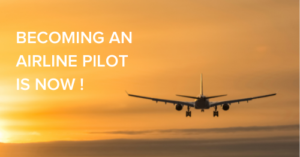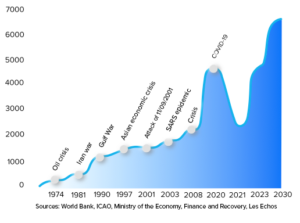The world is in crisis, the news channels only talk about Covid and pandemic, the economic news is catastrophic, and yet … Yet the green lights are on control. The indicators show very interesting signs.

First, let’s go back to the context. December 2019, Covid 19 begins to cause a stir. In China, the disease is already identified and scientists start to look at it. Politicians are starting to worry. The global economy with its transport of goods and people is accelerating the pandemic. In Europe, worries rise with the first cases and the rate of contagion is such that the first lockdowns begin. And the economy comes to a halt. In Europe, more than 90% of air transport has disappeared from the sky, globally it is more than 50%. The airlines suffer, the suppliers too, and then the manufacturers and their ecosystems too. A magnificent period of pilot recruitment, which began at the end of 2017, has stopped suddenly. And as usual, many believe this is the end of an industry.
But, aviation industry experts already know that there is reason for hope. A closer look at the analysis of global air transport since the 1970s shows that the crises have had little impact. Since the 1970s, global air transport has doubled on average every 15 years. Over the past 50 years, we have had crises that seemed insurmountable and each time passengers have wanted to continue travelling. Occasionally, we can see small plateaus on the curves, or even a short-lived drop, but very quickly it starts up again. Passengers and goods demand travel and get it.

This time there is a fundamental difference. In all previous crises, the economy and/or the customers held back the market. The increase in demand stopped. This time, the demand is still there. The global economy is just waiting to pick up. If the borders open up again, if travel can resume, then it will be a Jack London market. The frozen river is just waiting to break through the winter ice that holds it back and resume its normal flow. For the airline, it’s the same thing. The ice is Covid 19, but the river of transport is just waiting to start flowing again. The first indicators are already visible. The Chinese domestic market, with its draconian health controls, has resumed its previous rate of growth. A domestic market is not the world market. Of course it is! International trade will take a little longer to recover. The time it takes to get a vaccine and effective treatments, but we are getting there. England is authorising the distribution of the first vaccine, France will soon follow and the rest of Europe with it.
But is this a good enough reason to start training as a professional pilot now? A few things before answering.
– Just a few months ago, all the analysts were talking about a market of over 17 billion passengers in the 2030s. None of the analysts are backing down today, it could be the second half of the 2030s! However, they estimate that the full recovery will take about two years.
– Airlines have suffered. Financially very weakened, they will take two years to get back to the production capacity they had before. But the same airlines are taking advantage of this to clean up their organisation. The ‘papy boom’ of pilots, which was already there before, has continued its work. This movement has been accelerated by early retirements, often encouraged and helped by the companies to reduce the wage bill for flight crews. In many companies, a senior pilot costs twice as much or more than a junior pilot. Such an end of career is sad for the senior pilots, but it creates an opportunity for the young ones.
– During the next two years the airlines will resume their activities and first recruit pilots from the currently available pool. Pilots who are still young enough and still qualified. But then they will need new pilots to support the growth of the market.
“But that doesn’t justify starting training now! Well, it does! Training to become a professional pilot takes an average of two years. Two years of intensive work, with a strong commitment. Two years to absorb all the theoretical training and master the practical side. And after these two years, to be among those who will be suitable for employment in a market that has fully recovered, that has regained its former level, and above all that will resume its race to satisfy world demand. In the curve above, you see a Covid crisis that is deepening the market’s progress, but the recovery will be just as dramatic. Creating that V-curve described by economists.
Doubt it? Ask the people around you. They’ll tell you that they’re just waiting to start travelling again to see the world, to take a holiday, to meet up with their professional contacts, to live normally again.
Choose a good school, visit it, interview it and go for it!
 whatsapp
whatsapp


